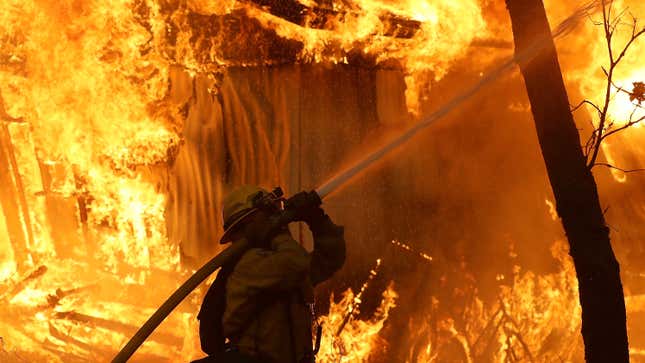
We know the planet is getting hot. Just how hot it will get is one of the biggest questions of the 21st century, tying up the fate of humanity and the biosphere in one neat hand basket to hell.
A 166-page study out today aims to help improve our understanding of how hot it will get by refining one of the most important metrics in climate science—what one researcher who worked on the paper dubbed the “holy grail” of research. The findings unfortunately show the best-case scenario is exceedingly unlikely, and heating will probably clock in on the higher end of previous estimates.
The metric scientists looked at in this massive paper, published Wednesday in Reviews of Geophysics, is something called climate sensitivity. It refers to how much the planet would heat up if we doubled the amount of carbon dioxide in the atmosphere compared to pre-industrial levels. That sounds like a simple thing to solve for, and indeed, scientists have a pretty good handle on what happens when you throw a bunch of carbon dioxide in the atmosphere. But carbon dioxide is only one teeny, tiny part of the equation.
Doubling carbon dioxide in the atmosphere sets off a cascade of reactions across Earth that push and pull the climate in different ways. Here is where I would make an analogy to convey how complex these interactions are, but it’s hard to come up with one, because capturing just how complex the entire planet is in a simple analogy wouldn’t do it justice. The complexity means that climate sensitivity has stood between 2.7 and 8.1 degrees Fahrenheit (1.5 and 4.5 degrees Celsius) for more than four decades.
“Climate sensitivity has long been the holy grail of climate science, as it’s the main factor—apart from our future emissions—that determines how much global warming will occur,” Zeke Hausfather, a climate scientist at the University of California, Berkeley who co-authored the paper, told Earther. “However, until now the range of likely sensitivity has been frustratingly difficult to narrow.”
The new paper aims to tighten that range a bit by exploring three key areas of climate: historical observations, explorations of feedbacks in the climate system, and paleoclimate records. Each of these provides an independent avenue of vetting climate sensitivity. The scientists were able to cross reference them and consider new lines of evidence. The layers within each of these areas of research is complex. The feedback portion of the analysis includes a look at a variety of specific clouds, all of which are affected differently by carbon dioxide-induced warming and have different warming (and cooling) effects on the planet. For example, low clouds over the ocean tend to trap heat. More heat is expected to increase this type of cloud cover in some locations, leading to more warming.
That’s just the tip of the cloud research iceberg, to say nothing of the other variables they considered, including Earth’s reflectivity, ice sheets, and even dust. Like I said: complex. Peter Cox, a University of Exeter climate scientist who wasn’t involved with the study, told Earther via email that the “paper is a monumental effort to consider multiple lines of evidence.”
The end result, sadly, shows that we can likely rule out the lower estimates of climate sensitivity. This is bad news, since lower sensitivity would buy us a little more time to address carbon pollution and adapt to heating. Instead, the results show that the likely range of global warming we can expect if carbon dioxide levels double is 4.7 to 7 degrees Fahrenheit (2.6 to 3.9 degrees Celsius). The former is well above the Paris Agreement target of 2 degrees Celsius (3.6 degrees Fahrenheit), meaning meeting it is essentially impossible if the world doubles pre-industrial levels of carbon dioxide. On the “bright” side, the study shows that the previously held upper limit of climate sensitivity is also unlikely.
“Climate change was always going to be a role of the dice, given the enormous complexity of the Earth’s climate and the challenge of predicting precisely how it will change due to human activity,” Hausfather said. “What we’ve done in this new study is found that rolling either a 1 or a 6 is a lot less likely than we previously thought.”
From a scientific perspective, knowing we’re more likely to roll a 4 or a 5 on the climate dice is an impressive finding, one that has eluded researchers since the 1970s. But make no mistake: This is bad news for humanity. It means the world has less time to act on climate. If we fail, and carbon dioxide doubles, the planet that’s allowed humanity to flourish would essentially be gone, replaced by a hellscape of dead coral reefs, relentless heat waves, drowned coastlines, and rising unrest and poverty.
The range that still remains is largely due to clouds, which continue to be a very active area. The work is an outgrowth of—and I swear this is the real name—the Grand Science Challenge on Clouds, Circulation, and Climate Sensitivity that began five years ago at a castle in Germany, an indication of just how important clouds are to the equation. Recent research has suggested clouds could be a greater source of heating than anticipated, but it’s still something being sussed out by scientists. Again, cool research, but I’d rather see the world cut carbon pollution and not give them the chance to find out if they’re right.